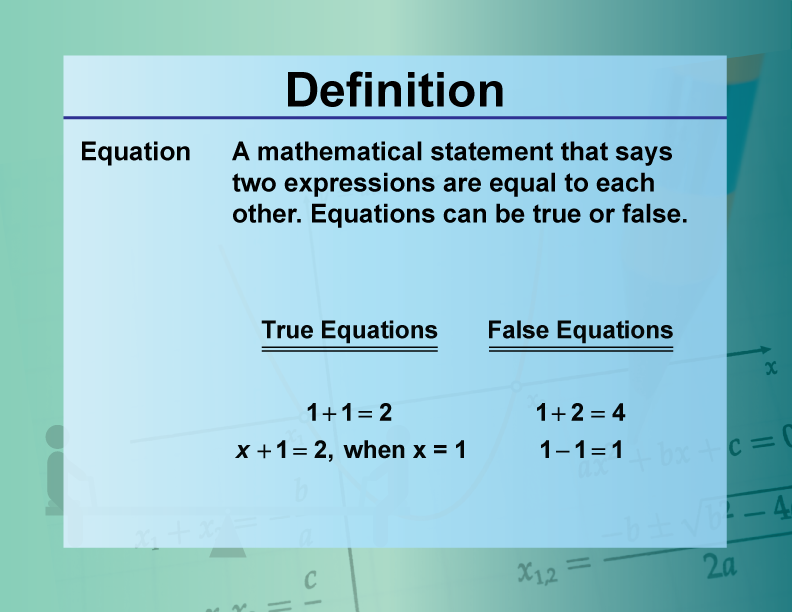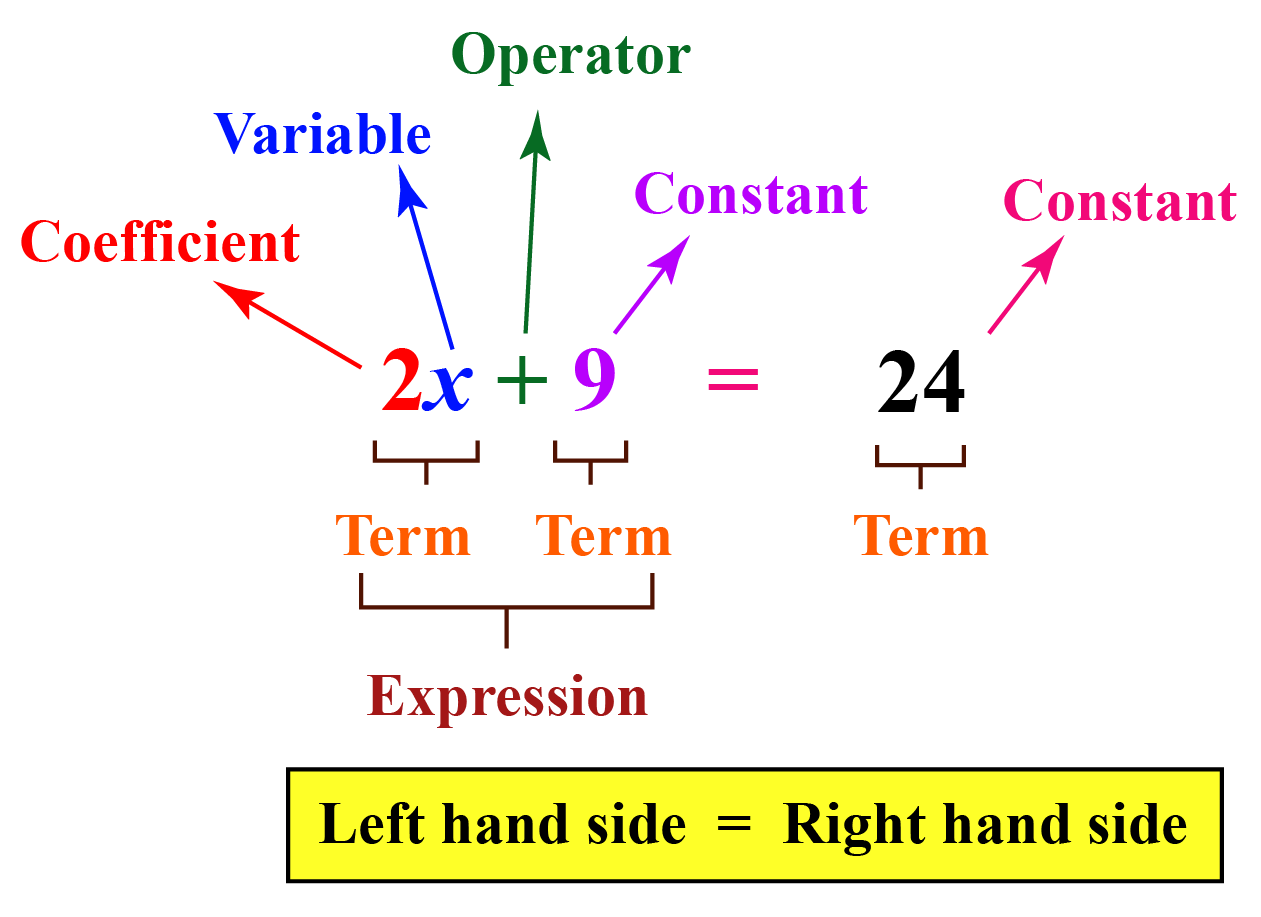Equation Explained: Definition, Types, And Examples!
Can a simple arrangement of symbols truly unlock the secrets of the universe? Indeed, the humble equation, that fundamental building block of mathematics, is far more than just a collection of numbers and signs it is a powerful tool that underpins nearly every aspect of modern life.
At its core, an equation is a statement of equality. It declares that two expressions hold the same value, much like a balanced scale. This seemingly simple concept has profound implications, enabling us to model the world, predict outcomes, and solve problems that once seemed insurmountable. The very word "equation" hints at its purpose: to "equate," to bring things into balance, to find the point where two sides converge.
Equations come in a bewildering variety of forms, each tailored to tackle specific challenges. Let's consider some key types, starting with the familiar territory of algebra. A linear equation, for example, is defined by a straightforward characteristic: the highest power of any variable is always 1. Graphically, these equations translate into straight lines, reflecting the direct, proportional relationships they represent. Think of the equation y = 2x + 1. This equation beautifully describes a straight line, the foundation of many concepts in coordinate geometry.
- Apple River Stabbing Sondra Mius Testimony Details
- Days Of Our Lives Will Abigail Deveraux Return Latest News
Then there are quadratic equations, where at least one variable is raised to the power of 2. These equations, often encountered in the study of parabolas, have a standard form: Ax + Bx + C = 0. Such equations find applications in a wide range of fields, from physics (describing projectile motion) to engineering (designing structures). The solutions to quadratic equations can be found through several methods, including factoring, completing the square, or the discriminant method. The discriminant itself the portion under the square root in the quadratic formula provides a powerful glimpse into the nature of the solutions: whether there are two real solutions, one real solution, or two complex solutions.
Cubic equations take the complexity a step further, introducing terms with a variable raised to the third power. These are equations where the highest exponent of at least one of the terms is 3. Their standard form, ax + bx + cx + d = 0, where a 0, can be solved using more advanced algebraic techniques, and the graphs of cubic functions exhibit a variety of curves and turning points.
Beyond the realm of polynomials, we encounter difference equations, a fascinating class of equations used to model systems that evolve over discrete time steps. Unlike the continuous nature of polynomial equations, difference equations involve a function f evaluated at different points, such as f(x), f(x-1), or f(x-k), where k is an integer representing the "order" of the equation. If we restrict the variable x to be an integer, a difference equation transforms into a recurrence relation, which is vital for analyzing patterns in sequences, data analysis and in the study of algorithms.
- California Net Pay Calculator 2024 Estimate Your Paycheck Now
- Alternatives To Apoquel For Dogs Is There A Better Option
Equations extend beyond simple algebraic expressions to include complex concepts. For example, a mathematical statement that asserts equality between two expressions, for example, 3x + 5 = 14, is an equation where both sides are balanced and solving it involves finding the value of x that makes this equality true. These equations are the engines that drive progress in so many fields. Simultaneously, they can be used to solve a wide range of problems in finance, science, engineering, and other fields.
The evolution of mathematics is a testament to the power of equations. The development of mathematical tools and systems has been driven by attempts to find answers to questions in a systematic way. Equations vary in complexity from simple, such as 7 + 2 = 10 - 1, that explain concepts in many scientific areas.
A linear equation, which is an equation for a straight line, is an algebraic equation where each term has an exponent of 1 and when this equation is graphed, it always results in a straight line. The process of photosynthesis is the perfect example to demonstrate the usage of the equation.
The equation of a straight line can be written in many other ways as well. Ax + bx + c = 0 is an example of a quadratic equation in standard form. Quadratic equations can be factored, and there are equations such as, X = -b (b - 4ac) / 2a;.
In addition to these forms, there are equations that can be used to solve problems in science. For example, when chemicals in solution react, the proper way of writing the chemical formulas of the dissolved ionic compounds is in terms of the dissociated ions, not the complete ionic formula. A complete ionic equation is a chemical equation in which the dissolved ionic compounds are written as separated ions.
An equation in math is made up of numbers and an equal sign that can include a variable in place of an unknown value. A variable is a letter that represents an unknown value. Linear regression is a statistical method that is used in various machine learning models to predict the value of unknown data using other related data values.
A regression equation is used in stats to find out what relationship, if any, exists between sets of data. For example, if you measure a childs height every year you might find that they grow about 3 inches a year. Equations can describe many processes. For example, cellular respiration is the process through which cells convert fuel into energy and nutrients. The process of photosynthesis occurs in two steps. Equations are the foundation of modern science.
In essence, equations provide a framework for understanding and quantifying relationships, making them indispensable in science, engineering, economics, and virtually every area of knowledge. The degree of an equation, determined by the highest power of the variable, dictates its behavior and the complexity of its solutions. Simultaneous equations, where multiple equations are solved concurrently to find a set of solutions that satisfy all of them, are crucial in scenarios where multiple variables are interconnected. The meaning of equation is the act or process of equating. The act or process of equating is an element affecting a process : it's a complex of variable factors.
Equations are not merely abstract formulas; they are tools for understanding the world. The applications are found in diverse disciplines, underscoring the versatility and power of these mathematical statements. As we delve deeper into the world of equations, we uncover an intricate and endlessly fascinating universe. Equations are more than just a mathematical concept; they are the key to understanding and describing the world around us. They are the language of science, the backbone of technology, and the foundation of countless innovations that shape our lives.
| Category | Details |
|---|---|
| Definition | A mathematical statement asserting the equality between two expressions, typically consisting of variables, constants, and mathematical operators. Equations are fundamental tools for representing and solving mathematical problems. |
| Purpose | To express relationships between quantities, to find unknown values (variables), and to model real-world phenomena. Equations help in making predictions and understanding the behavior of systems. |
| Components |
|
| Types of Equations |
|
| Solving Equations | Involves isolating the variable to find its value. This often involves applying inverse operations to both sides of the equation. Different types of equations require different methods for solving, such as factoring, completing the square, using the quadratic formula, etc. |
| Applications |
|
| Importance | Equations are essential for quantitative reasoning and are used across various fields. They provide a means of understanding and predicting behavior in complex systems, making them indispensable tools for problem-solving. |
| Examples |
|
| Related Terms | Variable, Constant, Coefficient, Term, Expression, Formula, Function, Inequality |
| Tools |
|
| Further Reading | Wikipedia - Equation |



Detail Author:
- Name : Glenna Rohan DVM
- Username : alfreda80
- Email : joshuah50@hotmail.com
- Birthdate : 1994-07-20
- Address : 315 Domenic Fort Apt. 929 Yessenialand, KS 91830-7816
- Phone : 1-283-873-4138
- Company : Hayes and Sons
- Job : Compacting Machine Operator
- Bio : Fugiat earum omnis voluptatibus rerum velit. Eaque tempore qui velit maxime. Aut voluptatem dolores dolor vel facere.
Socials
instagram:
- url : https://instagram.com/blaze_kiehn
- username : blaze_kiehn
- bio : Sint qui labore reiciendis quisquam. Necessitatibus at ab quos reprehenderit.
- followers : 6557
- following : 231
tiktok:
- url : https://tiktok.com/@blaze_kiehn
- username : blaze_kiehn
- bio : Dolor aut sequi et illum deserunt.
- followers : 6629
- following : 353
facebook:
- url : https://facebook.com/kiehnb
- username : kiehnb
- bio : Corporis delectus cupiditate perspiciatis quod nulla.
- followers : 1868
- following : 879
linkedin:
- url : https://linkedin.com/in/kiehn2012
- username : kiehn2012
- bio : Adipisci architecto modi dolorum sed et nostrum.
- followers : 2988
- following : 2402
twitter:
- url : https://twitter.com/blaze.kiehn
- username : blaze.kiehn
- bio : Rerum omnis sunt qui. Voluptatem et suscipit consequatur culpa. Iure in ullam nam odit illum.
- followers : 3888
- following : 442